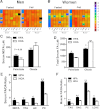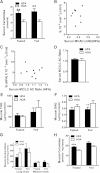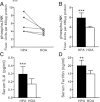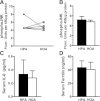A lipidomics analysis of the relationship between dietary fatty acid composition and insulin sensitivity in young adults
- PMID: 23238293
- PMCID: PMC3609566
- DOI: 10.2337/db12-0363
A lipidomics analysis of the relationship between dietary fatty acid composition and insulin sensitivity in young adults
Abstract
Relative to diets enriched in palmitic acid (PA), diets rich in oleic acid (OA) are associated with reduced risk of type 2 diabetes. To gain insight into mechanisms underlying these observations, we applied comprehensive lipidomic profiling to specimens collected from healthy adults enrolled in a randomized, crossover trial comparing a high-PA diet to a low-PA/high-OA (HOA) diet. Effects on insulin sensitivity (SI) and disposition index (DI) were assessed by intravenous glucose tolerance testing. In women, but not men, SI and DI were higher during HOA. The effect of HOA on SI correlated positively with physical fitness upon enrollment. Principal components analysis of either fasted or fed-state metabolites identified one factor affected by diet and heavily weighted by the PA/OA ratio of serum and muscle lipids. In women, this factor correlated inversely with SI in the fasted and fed states. Medium-chain acylcarnitines emerged as strong negative correlates of SI, and the HOA diet was accompanied by lower serum and muscle ceramide concentrations and reductions in molecular biomarkers of inflammatory and oxidative stress. This study provides evidence that the dietary PA/OA ratio impacts diabetes risk in women.
Figures






References
-
- Esposito K, Maiorino MI, Ceriello A, Giugliano D. Prevention and control of type 2 diabetes by Mediterranean diet: a systematic review. Diabetes Res Clin Pract 2010;89:97–102 - PubMed
-
- Gillingham LG, Harris-Janz S, Jones PJ. Dietary monounsaturated fatty acids are protective against metabolic syndrome and cardiovascular disease risk factors. Lipids 2011;46:209–228 - PubMed
-
- Hu FB, van Dam RM, Liu S. Diet and risk of type II diabetes: the role of types of fat and carbohydrate. Diabetologia 2001;44:805–817 - PubMed
Publication types
MeSH terms
Substances
Grants and funding
LinkOut - more resources
Full Text Sources
Other Literature Sources
Medical

